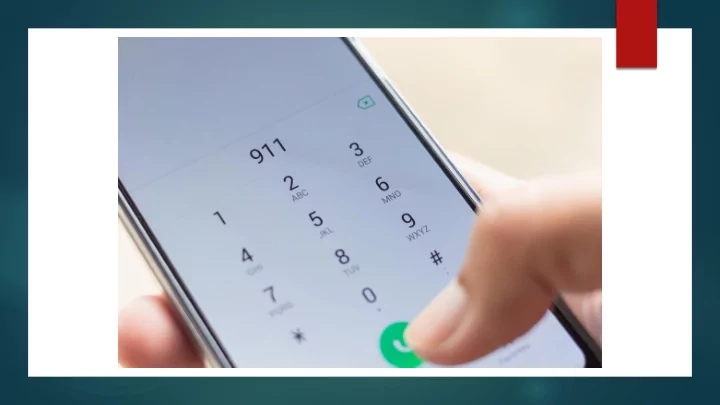

Emergency Numbers Systems Board Overview of Legacy E911 Overview of “Next Gen” E911 ENSB Cybersecurity Committee
Emergency Numbers System Board Formed in 1979, 17 Member board Coordinates installation and enhancement of county 9-1-1 emergency telephone number services systems. The board issues guidelines and determines review procedures to approve or disapprove county plans for these systems Provides for audit of Trust Fund accounts; and sets criteria for reimbursing counties. Recently passed “Carl Hen’s Law” which will add additional requirements “requiring the Board, in consultation with the Maryland Cybersecurity Council, to establish certain cybersecurity standards for public safety answering points; requiring the director of each public safety answering point to examine the cybersecurity of the public safety answering point under certain circumstances and to submit to the Board a certain report”
Legacy E-911 system All analog 911 trunks, currently provided by Verizon in all counties System has redundancy but is limited Each county has trunks from 2 different central office Most counties have a backup center in their county Each county can transfer calls to 1 other county using older technology call routing.
Add Cellular E9-1-1 Components Originating Calls Emergency Service Providers MSC – Mobile Switching Center Other ES ILECs CO Providers PDE/MDC - Selective Positioning Router Primary equipment CLECs CO PSAPs SRDB – Selective Secondary Router DBMS – WSPs MSC SR DB PSAPs Database Mgmt Cellular Dynamic System Updates ALI PDE MPC MSAG Wireline Subscriber Records DBMS or Cellular Shell Records Difficult and costly to integrate new call or messaging sources, and the corresponding data needs.
Adapt for VOIP - E9-1-1 Components Originating Calls Emergency Service Providers ESGW – Other ES Emergency ILECs CO Providers Services Gateway Selective Router Primary VPC – VoIP CLECs CO PSAPs positioning center ESGW Net - (routing of Call) Secondary Interne t VSPs SR DB PSAPs VoIP Dynamic Updates ALI Customer VPC Info DBMS Wireline Subscriber Records MSAG or VoIP Shell Records Difficult and costly to integrate new call or messaging sources, and the corresponding data needs.
E9-1-1 vs NG9-1-1 Complex analog trunking Engineered, managed IP networks (ESInet) and data network IP software selective routing Class 5 switch for Selective function Router GIS and database controls Translation based control Voice, text, video Limited to voice calls Bandwidth unlimited Data bandwidth 20 char Direct handling of Internet (digits) sourced calls Complex Emergency Standard IP interface Gateway Network for VoIP for all service types Custom interfaces for each service type
What’s Driving NG9 -1-1? ⚫ Newer technologies/services ▪ Text, image, video, telematics, sensors, subscriber info, emergency location info ⚫ Need to “mainstream” 9 -1-1 technology ⚫ Improve survivability ▪ Network resilience, virtual PSAPs ⚫ Improve interoperability and information sharing 8
How NG9-1-1 is Different ⚫ Technology ▪ IP Packet Based vs Circuit Switched ⚫ Interoperability ▪ No longer a “local” service ▪ Interoperates at county, region, state and national levels 9
How NG9-1-1 is Different (cont’d) ⚫ Functionality ▪ Replicates E9-1-1 capabilities and ▪ Adds new capabilities, direct control options ▪ Wide ranging additional data options ▪ GIS-based instead of tabular data for location validation and routing control 10
How NG9-1-1 is Different (cont’d) ⚫ IP SIP based (all call handling is SIP based) ▪ Uses numerous IETF RTFs, such as ECRIT, INVITE, REFER, BYE, PIDF-LO Example functional areas: ▪ Location Validation Function (GIS based) ▪ SIP ingress and call routing control (ESRP with ECRF) ▪ SIP delivery of call and data (multimedia supported) ▪ Queries for wide range of added data 11
NG9-1-1 Ecosystem NG9-1-1 Core Services ESInet
Call Information DB CIDB Next Generation 9-1-1 Location LIS Location Validation Information Sever GIS Function Originating GIS Data Networks Management GIS GIS Discrepancies LVF VoIP SIF ESInet BCF Access Control Enterprise ECRF BCF Admin Cellular PRF BCF Legacy Network Gateway NG9-1-1 PSAP PSTN ESRP Legacy SR Gateway Legacy Legacy PSAP PSAPs System Gateway Legacy Logging Legacy E9-1-1 Selective Networks Router This diagram is simplified for illustrative purposes.
The Nature of NG9-1-1 ⚫ Designed to support interoperability ⚫ Designed with open standards ⚫ Designed for and enables open competition ⚫ Enables a transition to competitive service provider environment ⚫ Necessitates regulatory (and legislative) change 14
NG9-1-1 Common Benefits PSAPs and Responders ⚫ Text/IM to 9-1-1 ⚫ Files to 9-1-1 , such as photos or video clips ⚫ Streaming video ⚫ Telematics and sensor data ⚫ Additional Data available 15
NG9-1-1 PSAP Benefits ⚫ Virtual PSAP (geographically distributed) ▪ NG9-1-1 controlled to individual or hosted CPE ⚫ Nomadic and/or mobile call taker workstations ⚫ Policy-based alternate routing with new options ▪ To alt PSAP, or spreading calls to multiple PSAPs ▪ Invoked directly within minutes by PSAPs (online) ⚫ Additional Policy-based routing for: ▪ Language preference of caller ▪ Type of technology > IM, Sensor, Satellite phone 16
NG9-1-1 Responder Benefits ⚫ Informative data to dispatch and field responders ⚫ National standards for data interfaces ⚫ Adaptable for future needs ⚫ Text/IM via 9-1-1 17
ENSB Cybersecurity Subcommittee Senate Bill 339: Public Safety – 9-1-1 Emergency Telephone System (Carl Henn’s Law) This bill enhances and alters the regulatory framework that governs the State’s 9 -1-1 system. Cybersecurity Standards (minimum standards) Cybersecurity, oversight and accountability of service level agreements between counties and NG service providers In consultation with the Maryland Cybersecurity Council National industry and 9-1-1 system trade association best practices Response protocols for an attack PSAP director to certify the PSAP meets Board standards and a report detailing the exercise leading to the certification prior to PSAP receiving any Board funding
Cybersecurity and Investigations 19 Cybersecurity • Identify minimum standards for cybersecurity, oversight, and accountability of service level agreements between counties and core service providers of NG911 services • Recommend a COOP template including cybersecurity risk mitigation strategy and annual evaluation/practice • Identify suggested requirements for local agency compliance, based on industry standards and best practices surrounding NG911 technology and cybersecurity protection and prevention Investigations (Ad Hoc) • As needed to investigate network or PSAP-affecting events to provide after action reporting to the board
Recommend
More recommend